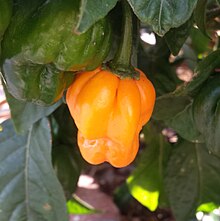This article needs additional citations for verification. (August 2015) |
Scotch bonnet (also known as Bonney peppers, or Caribbean red peppers)[1] is a variety of chili pepper named for its supposed resemblance to a Scottish tam o' shanter bonnet.[2][3] It is native to the Americas—a cultivar of Capsicum chinense, which originated in the Amazon Basin, Central and South America.[4][5]
| Scotch bonnet | |
|---|---|
 | |
| Species | Capsicum chinense |
| Cultivar | 'Scotch Bonnet' |
| Heat | |
| Scoville scale | 100,000-350,000 SHU |
History
editThe indigenous Amerindians of the Antilles, the Tainos and later the Caribs, transported scotch bonnet peppers and other staples like cassava and sweet potato on huge canoes. Both of these Arawakan subgroups originated in the Orinoco River Valley (present-day Venezuela). The Tainos from the Yucatán Peninsula and Belize were pioneers in traveling to the Greater Antilles, and they took a variety of chilies with them.[6][7] They have since become a staple of Caribbean cuisine, especially Jamaican cuisine.
In the 15th and 16th centuries, Spanish and Portuguese colonizers introduced scotch bonnets to other regions. Through the Columbian exchange , the five domesticated species of Capsicum were introduced to Europe, Africa and Asia,[8] where more varieties developed across the globe. They became so popular in Asia and Africa, that many consumers there are unaware of the chili peppers' Mesoamerican origins.[9]
Like the closely related habanero, scotch bonnets have a heat rating of 100,000–350,000 Scoville units.[10] For comparison, most jalapeño peppers have a heat rating of 2,500 to 8,000. A completely sweet variety of scotch bonnet, cachucha, is grown on some Caribbean islands.[11]
Cuisine
editScotch bonnets are used in many cuisines worldwide, and are often used in hot sauces and condiments. They are often compared to habaneros, since both varieties are very similar and are of the same species, with the same level of heat and pungency. However, scotch bonnets have a sweeter flavour profile and stouter shape.
Scotch bonnets are mostly used in Caribbean, West African, Sri Lankan, and Maldivian cuisines and pepper sauces. In Jamaica, it is a key ingredient in many popular Jamaican dishes such as jerk, which is also of Taino origin and indigenous to the island.
In Latin American cuisine, they are often used as a substitute for other similar peppers, like habaneros. Scotch bonnet is also used in Nicaragua, Costa Rica and Panama for Caribbean-styled recipes such as rice and peas, rondón, saus, beef patties, and ceviche.[citation needed]
-
Scotch bonnet peppers in a Caribbean market
-
A single ripe Scotch bonnet pepper
See also
editReferences
edit- ^ "Chili Peppers Recipes".
- ^ DeWitt, Dave (1996). Pepper Profile: Scotch Bonnet. Fiery-Foods.com.
- ^ Andrews, Jean (1998). The Pepper Lady's Pocket Pepper Primer. University of Texas Press. p. 147. ISBN 978-0-292-70483-1.
- ^ "PEPPER: Capsicum spp by Carlos Quiros". Archived from the original on 2016-01-22. Retrieved 2024-11-16.
- ^ "Pima County Public Library Blog-Some Like It Hot: Chilis, the Spice Of Life". 2022-09-16. Retrieved 2024-11-17.
- ^ "Jamaica: The Scotch bonnet's journey from the Orinoco River Valley to the jerk pit by Bill Esparza". 2017-08-16. Retrieved 2024-11-15.
- ^ Reynoso-García, J.; Santiago-Rodriguez, T. M.; Narganes-Storde, Y.; Cano, R. J.; Toranzos, G. A. (2023-10-11). "Edible flora in pre-Columbian Caribbean coprolites: Expected and unexpected data". PLOS ONE. 18 (10): e0292077. Bibcode:2023PLoSO..1892077R. doi:10.1371/journal.pone.0292077. PMC 10566737. PMID 37819893.
- ^ "The Columbian Exchange: A History of Disease, Food, and Ideas by Nathan Nunn and Nancy Qian pg 171" (PDF). 2010. Retrieved 2024-11-15.
- ^ "Jamaica: The Scotch bonnet's journey from the Orinoco River Valley to the jerk pit by Bill Esparza". 2017-08-16. Retrieved 2024-11-15.
- ^ "Hot Chili Peppers on the Scoville Scale: Measuring chili pepper heat in Scoville units". The Spruce Eats. The Spruce. Archived from the original on 29 May 2018. Retrieved 2008-08-21.
- ^ "What Is Ají Cachucha (Ají Dulce) Pepper?". 28 April 2023. Retrieved 2024-11-17.
External links
edit- Media related to Scotch Bonnet at Wikimedia Commons